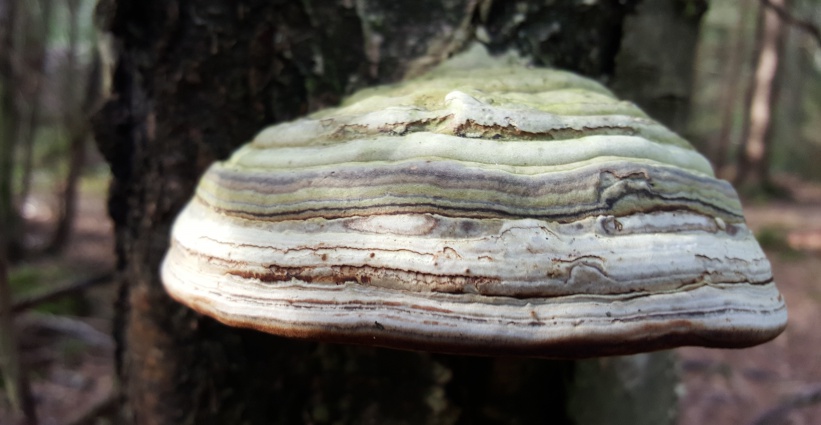One day after posting the Woodchuck Firekeeper blog, I knew I had to find an answer to the birch tinder fungus question and mystery, so on a Blue Moon, the day before New Year’s Eve, I called my friend Ray Reitze who has taught wilderness ways and skills at the Earthways School of Wilderness Living for decades. Ray lives with his wife Nancy in a handmade, off the grid, wood heated log cabin “hogan” in Canaan, Maine.
When I called, both Nancy and Ray were home. Nancy who answered the call was sure there were lots of ways to carry fire, and she eventually hooked me up with Ray. I told him about the spiral fuse in a clay body inside of clamshells and added my Woodchuck Firekeeper news. I also told him about the wonderful new book by Kerry Hardy which is a field guide to the Maine Wabanaki people in the period just before and during early European contact. The book, Notes on a Lost Flute, is full of wonderful tales, photos, drawings and detective stories on unraveling the original meaning of many of the Indian place names in Maine, including Norridgewock where we’ve lived for over 35 years. The original prehistoric village of Norridgewock is built at the confluence of the Sandy River, which flows out of the Western Mountains near Rangeley and the Kennebec River, and originates in Maine’s largest lake, Moosehead. When the Sandy tries to enter the strong current of the Kennebec it can’t simply enter that traffic pattern of water. Instead, it has to flow North upstream along the Western bank of the Kennebec before it can ease into the downstream Southerly flow of the river. This image of a river flowing in two directions at the same time and in the same place is the meaning embedded in the name, Norridgewock. I have read attempts to decipher the meaning of the name for nearly forty years and it is Hardy’s explanation that has me won over. I really like Hardy’s book.
When Ray was a boy, he was befriended by a Mic Mac Indian elder who Ray refers to as Grandfather. Grandfather taught Ray many of the old woods ways and the deeper connections to the natural world and Ray has passed this same deep connection to the natural world on to his hands-on wilderness students for years.
Grandfather taught Ray that “Spruce is the Keeper of the Spark.” I asked Ray what he meant by that and Ray said that in the matter of a bow drill spindle, many woods have been tried, but the best one to make a spark is a spindle made of spruce. With a spruce spindle and a good fire board under foot and spindle cover piece nestled in the palm of one’s hand and good tinder ready at hand to receive the coal, spruce could reliably provide the “Spark” to make a fire. I told Ray about the clay and clamshells and some kind of fungal fuse associated with Birch and Ray knew exactly what I was referring to and had learned this as well from Grandfather, that: “Tinder Fungus is the Keeper of the Fire.” Ray says that tinder fungus is a jagged black fungus that grows on white birch and yellow birch. When collected, dried and lit from another fire, it will smolder and glow but not leap into flame. It can be made into a fuse and packed into fairly dry clay, perhaps as a spiral fuse and carried “lit” all day. Ray had done it with “conch” shells and clay with the lit tinder birch fuse in the middle and the two shells tied together and carried in a pack basket, perhaps with the basket in a canoe. Ray said that the glowing fuse is so strong that you cannot make it go out unless you cut the glowing part out with a knife and submerge it in water.
After I spoke with Ray I went online and Googled “tinder fungus” and found literally hundreds of entries, including a short video on the birch tinder fungus. I had just finished the video when a knock on the door came from a man from New Zealand who had been calling me for three days about a visit to talk about masonry heaters there. His wife was wearing a beautiful green stone pendant hung on a finely knotted leather or fiber necklace of Maori handwork. Charles and his wife said that the Maori natives of New Zealand also carried fire with them when they moved around and he would research this for me as soon as they got home. Charles may be coming to the New Zealand hands-on workshop in early February 20l0. He wants to develop a low cost sustainable masonry heater design and system for New Zealand. We spent quite a lot of time together in the kitchen showing them the first Finnish brick cookstove that I ever built about thirty years ago. It still works beautifully.
In one day asking for answers to the tinder fungus mystery, two people came into my life with more stories of carrying and Keeping the Fire. The deeper we connect to the ancient wisdom of the Woodchuck, the Spruce and the Tinder Fungus, the more likely it is that we will finally remember what we have nearly completely forgotten how to do, how to live gently on this magical home called Earth.




